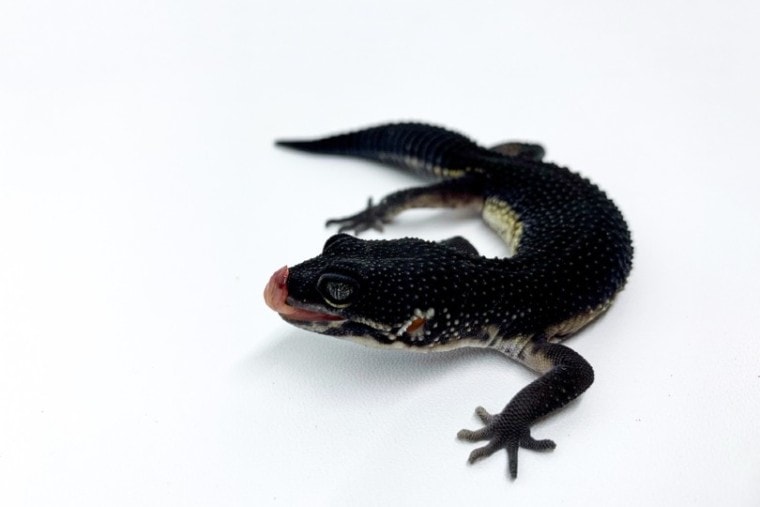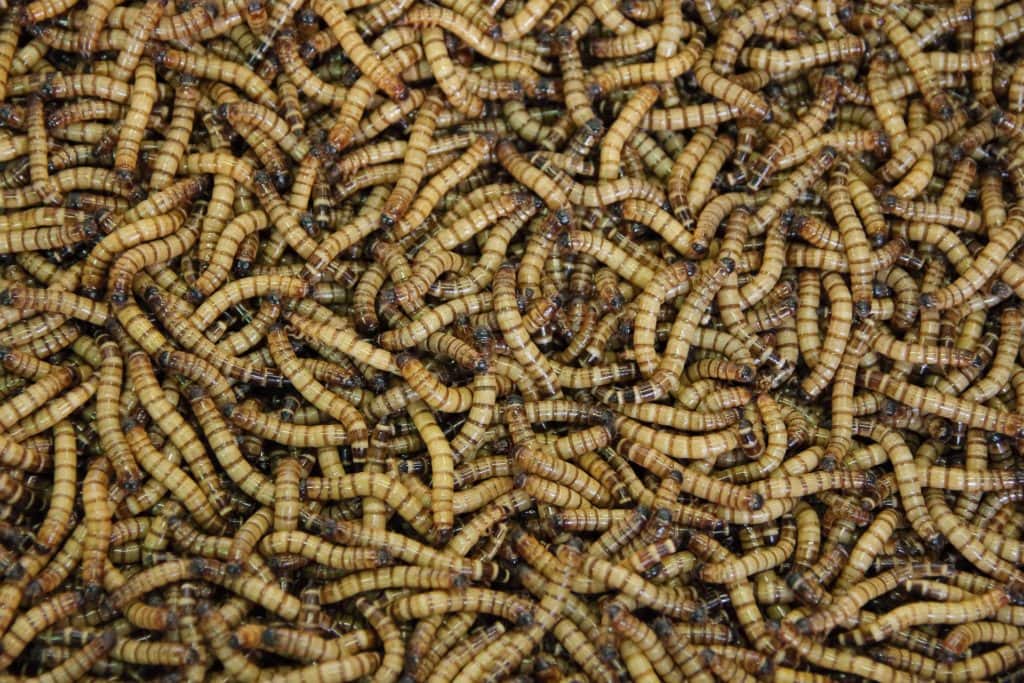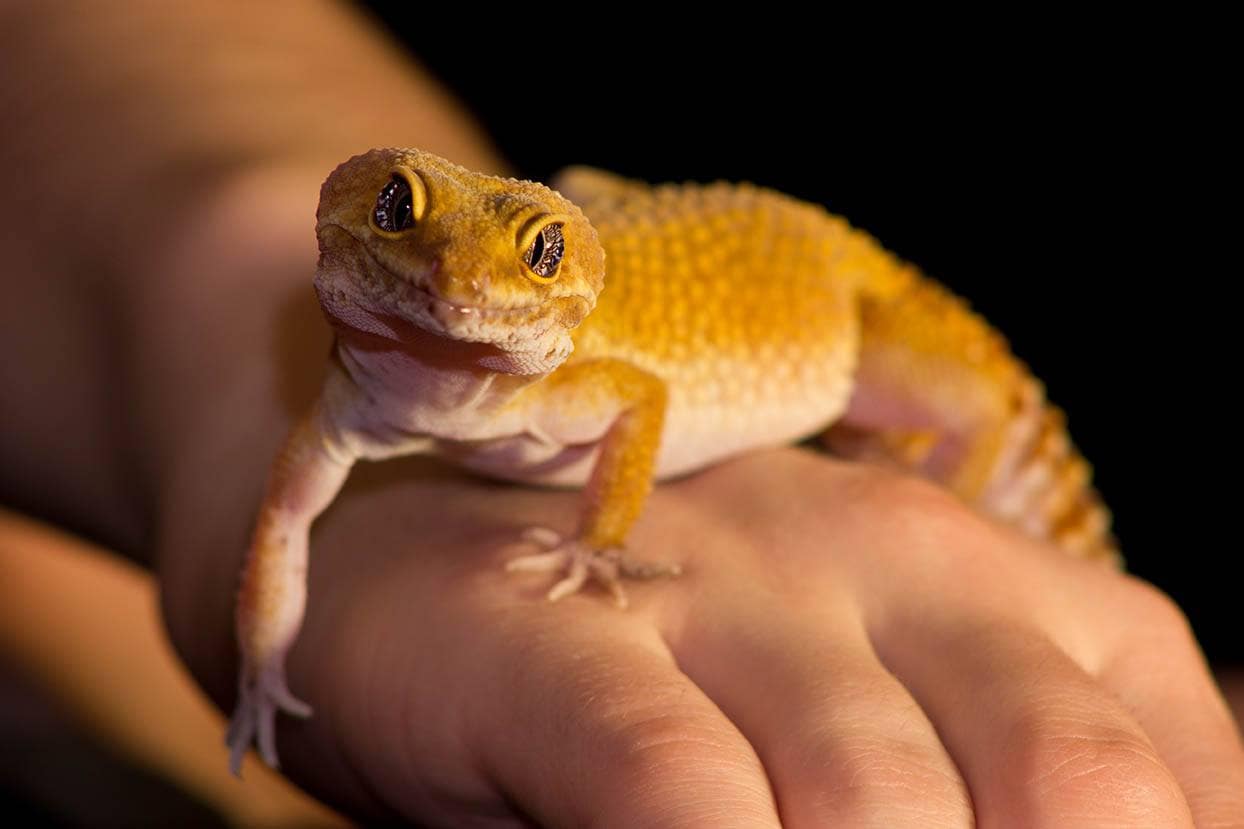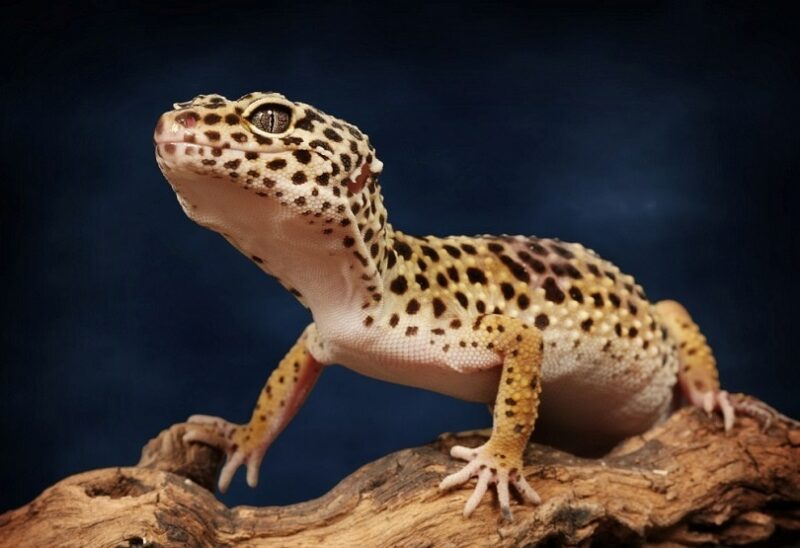
The Black Night Leopard Gecko is a rare leopard gecko morph that has been bred for its color. It is a very dark morph, or, to give it its proper technical term, it is a hypermelanistic leopard gecko. It is described as being full black with no pattern whatsoever. The morph is a small gecko and like most line bred morphs, it is prone to some health issues.
Quick Facts about Black Night Leopard Geckos
| Species Name: | Eublepharis macularius |
| Common Name: | Black Night Leopard Gecko |
| Care Level: | Low |
| Lifespan: | 15–20 years |
| Adult Size: | 6–7 inches |
| Diet: | Insects, vegetables, water |
| Minimum Tank Size: | 20-gallon tank |
| Temperature & Humidity: | 72° F–88° F and 40% humidity |
Do Black Night Leopard Geckos Make Good Pets?
Easy to care for and happy to be held, the leopard gecko has long been a popular family pet that is considered suitable for family members of all ages. The Black Night morph is especially popular thanks to its incredible pitch-black appearance.
They do require that owners offer them favorable conditions and that you look after them, but they are easier to care for than most other lizards. The Black Night is more prone to diseases than other leopard geckos because it has been intensively bred, but it is still a good pet.
Appearance
A triangular head, a long body, and a thick tail are the main characteristics of the leopard gecko. They have slit pupils, and while there are dozens of different morphs that are intentionally bred for different appearances, there are few that are as rare or as striking as the Black Night morph. While most dark morphs still have visible coloration and pattern, this is not true of the Black Night.
How to Take Care of Black Night Geckos
The Black Night Leopard Gecko is one of a host of leopard gecko morphs, most of which are popular as pets because they are considered low maintenance and easy to care for. With that said, you do still need to meet the specific requirements of this lizard to ensure that it is happy and healthy.
Habitat, Tank Conditions & Setup
Tank
There is always debate over the ideal size of a lizard tank. While some owners say that 15 gallons offers ample volume for a leopard gecko tank, you should aim for a minimum of 20 gallons, and ensure that it is a long tank design. This space allows you to offer gradient heat, as well as basking and feeding areas, without having to try and cramp everything into one space.
Lighting
Although humidity is considered relatively easy for this breed, you do need to ensure proper lighting. Provide a basking bulb for daytime and ceramic for the night. This species prefers cool white to bright white lights.
Heating
One end of the tank should be 75° F and the other end 90° F, and there should be a gradient from one side to the other allowing your gecko to regulate temperature as needed and when required. Combine a basking lamp and under tank heater to reach the desired temperature. Humidity should match that of the desert, where it is a relatively dry 30% to 40% humidity. Have a single bowl in the enclosure. This should be enough to provide the water your lizard requires without being so large that it increases the humidity level too much.
Substrate
Cloth, towel, coconut fiber, or aspen shavings are the most appropriate substrate for this lizard. Do not use sand because this can lead to impaction, which is painful and potentially fatal.
| Tank Recommendations | |
| Tank Type | 20-gallon tank |
| Lighting | Basking bulb and ceramic lamp |
| Heating | Basking lamp and under tank heater |
| Best Substrate | Aspen bedding, coconut fiber, cloth, or towel |
Feeding Your Black Night Leopard Gecko
The leopard gecko lives on a diet consisting of insects. They will eat mealworms, superworms, crickets, and Dubia roaches. Juveniles should be fed every day and receive one insect that is smaller than the distance between the lizard’s eyes. Adults should eat every 3 days and be given one insect for each inch of gecko.

| Diet Summary | |
| Fruits | 0% of diet |
| Insects | 100% of diet |
| Meat | 0% of diet |
| Supplements Required | Calcium and vitamin D3 dusting |
Keeping Your Black Night Leopard Gecko Healthy
The breed is known to have autonomy, which means that they will drop their tails if they get stressed. The tail will grow back but you should ensure that the gecko is clean and remains free from bacteria during this time.
Common Health Issues
Lifespan
The leopard gecko will live between 15 and 20 years in captivity, with some reaching 25 years. However, the average life expectancy of a morph like the Black Night, which has been heavily line-bred, is around 15 years.
Breeding
You can house one male and two females if you intend to breed. This should not cause any fighting, and it will increase the chance of successfully producing a clutch of eggs. Each lizard will need its own hide and you will have to ensure a temperature between 72° F and 75° F before you want your leopards to breed.
A clutch will contain two eggs and a female can produce five clutches in a single season.
Once the eggs have been laid, remove them and incubate between 80° F and 90° F. Hotter temperatures will result in males, colder temperatures will yield females, and middling temperatures will provide a mix of genders.
Are Black Night Leopard Geckos Friendly? Our Handling Advice
One of the reasons for the Black Night Leopard Gecko’s popularity as a pet is its willingness to be handled.
This species of lizard is inquisitive and likes to explore, including human hands and arms. They will usually gladly sit on your arm and will rarely bite, but you should never pick them up by the tail. Start with short handling sessions, lasting around 4–5 minutes, and extend them as your gecko becomes comfortable with the current session length.
Shedding: What to Expect
Young geckos will shed every week or two while adults will shed approximately every month to two months.
How Much Do Black Night Leopard Geckos Cost?
Black Night Leopard Geckos are one of the rarest morphs and this is represented in their price. You can expect the Black Leopard Gecko price to be upwards of $2,000 for one of these striking-looking morphs.
Care Guide Summary
Final Thoughts
The Black Night Leopard Gecko is a rare but striking example of a leopard gecko morph. Its pure black appearance combines with the low maintenance and inquisitive nature of the species to make this a somewhat sought-after breed. But a hefty price tag and difficulty getting hold of the morph means that it is very rare.
Featured Image Credit: worenpets, Shutterstock








